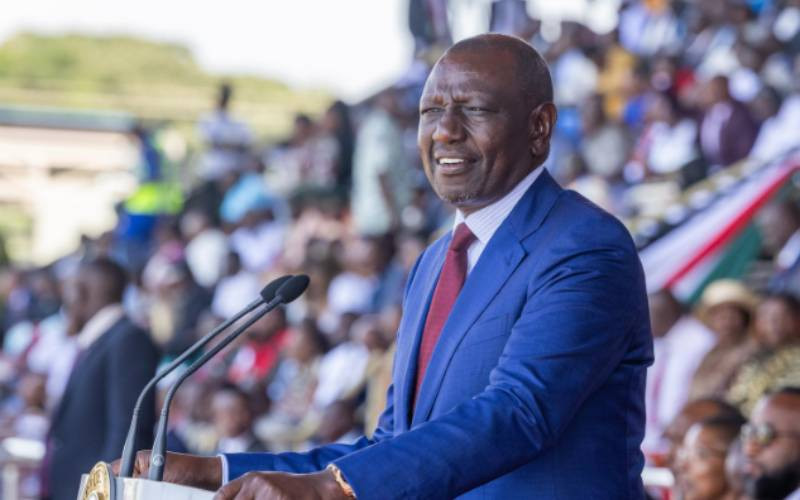Standing before thousands gathered at the Raila Odinga Stadium in Homa Bay, President William Ruto on Sunday painted a picture of a country on the rise.
Kenya, he said, had weathered global economic shocks and was now charting a path of sustained growth—highlighting a stronger currency, lower inflation, and bold social investments.
“The shilling has appreciated by nearly 20 per cent against the US dollar,” Ruto told the crowd during Madaraka Day celebrations. “From Sh162 down to Sh129—among the best-performing currencies globally.”
That rise, he argued, was a reflection of deepening investor confidence and economic resilience. But some economists say the recent rally may owe more to short-term inflows—such as international loans and Eurobond support—than to long-lasting fundamentals.
Still, the president didn’t hold back on numbers. Kenya’s GDP, he said, is projected to hit $132 billion this year, making it the region’s largest economy and the sixth biggest in Africa.
“Since August 2022, we have maintained an annual growth rate of five per cent,” he said—outpacing both the global average of 3.3 per cent and sub-Saharan Africa’s 3.8 per cent, according to the International Monetary Fund.
Inflation, once a pressing concern, has eased sharply—down from 9.6 per cent in October 2022 to 3.8 per cent in May. That’s now below the government’s target of five per cent.
The Central Bank Rate has also dropped—from 13 to 10 per cent—slashing borrowing costs for households and businesses. Meanwhile, foreign exchange reserves stand at $10 billion, enough to cover four months of imports.
Housing, Jobs, and Healthcare
Ruto also highlighted progress in affordable housing—a cornerstone of his economic agenda. He said over 11,000 units had been completed so far, and more than 250,000 jobs created in the process.
“In Mukuru Estate, I handed over keys to the first 1,080 social housing units,” he said. “And 110 more in Homa Bay.”
A proposed law, he added, will allow citizens to borrow up to Sh5 million in affordable home loans at single-digit interest rates—another step to expand access to home ownership.
On health, the president said 23 million Kenyans are now registered under the newly launched Social Health Authority. So far, it has disbursed Sh43 billion to medical facilities and fully covered treatment for 4.5 million patients.
“For the first time in our history,” Ruto said, “citizens can now access free emergency services in all health facilities.”
Farming Gains and Food Prices
Ruto also pointed to a rebound in agricultural output. Thanks to fertiliser subsidies, food production is up by 50 per cent. Milk farmers now earn Sh50 per litre, up from Sh35, while coffee prices have more than doubled to Sh150 per kilo.
Tea earnings hit Sh215 billion last year, up from Sh138 billion in 2022. Sugar production rose too—from 490,000 to 815,000 metric tonnes.
The leasing of four struggling state-owned sugar mills, Ruto claimed, would bring “efficiency and accountability” to a once-beleaguered sector.
Education and Youth Programmes
In the classroom, the government has hired 76,000 teachers in two years, with plans to recruit another 24,000 by January 2026. Enrolment in technical and vocational institutions is expected to quadruple—from 500,000 in 2023 to 2 million by year-end.
The Hustler Fund, a flagship microloan programme, has reached over 25 million borrowers and disbursed Sh70 billion, the president said. Borrowers have saved Sh4.5 billion collectively.
Ruto also unveiled a Sh20 billion partnership with the World Bank to support youth employment. An additional Sh5 billion in grants will go to 100,000 young people.
The Blue Economy and Infrastructure Push
Ruto laid out ambitious plans for Kenya’s blue economy, saying it could grow from Sh36 billion to Sh400 billion with the right investments.
Seven modern fish landing sites have already been completed along the Indian Ocean and Lake Victoria. Five more are under construction, and nine new ones are planned.
Lake Victoria, he added, now hosts over 4,000 fish cages, producing 12,000 metric tonnes of fish annually.
In transport, 1,800 kilometres of new tarmac roads have been completed. More than 134,800 kilometres of roads have been maintained. Construction is set to begin on a long-awaited dual carriageway from Mau Summit to Rironi, extending through Eldoret to Malaba.
Critics Remain Cautious
Despite the upbeat address, critics remain sceptical about how deeply these gains are felt by ordinary citizens.
“Headline numbers look good,” said Kwame Owino, an economist with the Institute of Economic Affairs in Nairobi, “but the real question is whether the cost of living has genuinely come down for most Kenyans.”
Fuel and electricity prices remain high. Youth unemployment and public debt levels are still major concerns. And not all housing projects have gone up without controversy—some residents in informal settlements claim they’ve been displaced without adequate notice or compensation.
Still, on Madaraka Day—a moment that commemorates Kenya’s path to internal self-rule—Ruto made clear he sees this as a turning point.
“Our journey is far from over,” he said. “But we are walking with purpose.”

